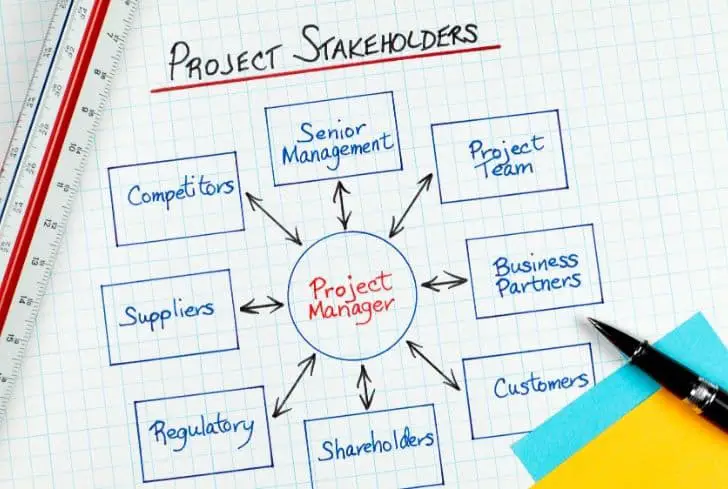What is Stakeholder Management?
A project does not exist in isolation. It will affect people, groups, and organizations, collectively known as stakeholders. Simply put, stakeholders can make or break a project, and their management is a key element of project management.
A well-structured project has several key elements:
- A Project Charter, setting out the background to the project, it’s the business rationale, and its scope based on the project statement of work. It will also include any external factors that need consideration.
2. A Project Management Plan, setting out how the project is to be managed and controlled
3. A Project Plan, setting out the tasks to be undertaken, their timing, their interdependencies and the resources needed to complete them.
4. Change Management Plan
5. Risk Management Plan
6. Stakeholder Management Plan
While they are all important and indeed vital to the successful execution of the project, stakeholder involvement is essential, particularly for larger projects.
Stakeholder management is a bit of a moving target since it will depend to a great extent on the culture and business strategy of the organization in which the stakeholders exist and the expectations of the stakeholders themselves. A Stakeholder Management Plan is a key element in a project plan.
The basic functions of the process to create the Stakeholder Management Plan are to:
- Identify Stakeholders
2. Identify and record stakeholder expectations
3. Develop and implement strategies for:
-
-
- Stakeholder engagement in project execution
- Stakeholder communication
- Issue Management
-
4. Stakeholders in the Change Management process
1. Measure and manage Stakeholder satisfaction
2. Create the Stakeholder Management Plan
1. Identify Stakeholders
This process is that of identifying interested parties to the project. It may not be obvious who they are, so some research will be required. Stakeholders may come from outside an organization. In business, stakeholders could be suppliers and customers, perhaps even the general public.
In short, a stakeholder is someone who is affected or considers themselves to be affected by the execution of the project or its subsequent implementation.
Some commentators think that there are two types of stakeholder:
- Project Stakeholders.
They are concerned with the execution of the project and how it impacts on their workplace but are not affected by the implementation of the project itself. Their involvement ends with the end of the project. They could be considered as resource providers to the project, but their input to the execution process is vital.
Internal departments, including Admin, Security, Facilities Management, Procurement, HR and ICT will be involved in the setting up and execution of the project and are likely to be project stakeholders.
- Institutional Stakeholders.
Institutional Stakeholders will be affected during project execution, but are mainly concerned with the changes to their workplace following the implementation of the project. The project charter will indicate those internal departments that will be institutional stakeholders. The business process flow will also tell you who they are.
Some stakeholders may fall into both categories. How you deal with stakeholders will differ according to their category and that needs to be reflected in the stakeholder management plan.
The stakeholders must be identified and recorded with full contact details in a stakeholder register. Stakeholders may also be active for parts of a project, their influence and involvement coming into play or falling away at different stages of the project. This also needs to be noted in the register.
It is also important to understand that the stakeholder register is a living document and will need to be updated regularly.
2. Identify and Record Stakeholder Expectations
There is the management dictum “If you don’t measure it, you can’t manage it”. Stakeholders will have expectations as to how the project will proceed and how the ultimate objective will affect them. You need to know what those expectations are, so you can make sure the project stays on track.
The stakeholder management process needs to be built into the overall project plan. Expectation measurement and management is part of that process.
It is difficult to be hard and fast on how to do this since you are entering an area in which stakeholders have their own priorities and objectives. It is more a people management exercise, and sometimes inter-personal and inter-departmental political issues arise.
The project probably will be taking people out of their comfort zone, so people may be reluctant to come on board. Sometimes your project may conflict with their objectives or have a low priority in their lives. They may not tell you the full truth and in some cases make outright misrepresentations. Your expert judgment will be needed to make an assessment.
On the other hand, they may enthusiastically join a project that brings benefits to them.
It is important to identify stakeholders that have a vested interest in the project failing so coping strategies can be developed. Expectation management often requires careful and sensitive handling.
One final point, internal stakeholders may have career expectations that depend on the success or otherwise of the project. Be careful of these.
Use meetings and expert analysis to flesh out your view of stakeholders and their expectations. Try, and it is sometimes difficult, to identify those stakeholders that will be enthusiastic supporters, those that will be a minor irritant and those that could or want to stop the project in its tracks.
The outputs of this stage include:
- A stakeholder management plan
- Updates to the overall project management plan
3. Stakeholder Engagement in Project Execution
Having prepared the management plan, the next step is to implement it during project execution. Be aware that the plan is a living document and will probably need amendments as you go through the project to meet changing requirements.
Also, it is not to be used in isolation. Most importantly, it needs to be aligned with the project communications plan and change management.
Stakeholder Communication
Communications is the life-blood of any stakeholder management strategy. People will guess, usually wrongly, and make things up if they are kept out of the loop. Communications is also a two-way street. If you don’t communicate with stakeholders they are disinclined to communicate with you. You might miss an important development in the project or business environment that changes the scope or validity of the project or your assumptions about stakeholder engagement.
It cannot be emphasized enough that many projects have failed or run over time and budget because of a lack of communication with the stakeholders.
A further point is that if the project is running into difficulties, it is far easier and more successful to ask for help from the stakeholders when they have been fully involved in the process than to surprise them with a sudden request for more time or money.
4. Stakeholders in the Change Control and Issue Management Process
Changes will inevitably be needed during project execution, particularly in lengthy projects. A business is not a static entity and assumptions about business requirements and the consequent deliverables may become invalid.
There will also be the “it’s just a small change” requests from users speaking to implementors at the coal face. It may be a small change, but they add up and can have an effect on resources and timings. There may also be unintended consequences of implementing so-called minor changes outside the formal process.
Involving stakeholders in the change process will achieve several things:
- They become aware of the need for continual communications.
- They understand the need for fixed goalposts to prevent project slippage with the consequent time and budget implications, and the need to stop “it’s just a small change” requests.
- They become aware of the true scape and extent of the project and how it affects them.
5. Measuring and Managing Stakeholder Satisfaction
Involving stakeholders will also give the opportunity to continually measure and monitor stakeholder satisfaction with the way things are going. Stakeholders are often happy with the project on paper, but not so happy when they see it in the flesh. On longer projects business needs will change, and on all projects, mature reflection may change a stakeholder’s view of the project scope and requirements as defined in the project plan.
You need to use change management, meetings and general informal chat around the water cooler to gauge individual stakeholder’s views of the project. This will help you identify current problems and hopefully provide a warning of any potential problems that may arise in the longer term.
How you deal with them rather depends on what the issue is. Small issues can usually be dealt with quickly, but if the issue is one of the changes to project scope or timings, then this will need to be brought formally through change control.
You mustn’t make unplanned knee-jerk changes in response to stakeholder demands.
6. Creating the Stakeholder Management Plan
The Stakeholder Management Plan is built around the stakeholder register. The register is always an electronic document, often in spreadsheet form.
It will hold:
- Basic Information:
- Stakeholder details, including up and down reporting channels
- Stakeholder Contact details
- A brief description of the stakeholder’s interest in the project
- Ongoing information:
- Change requests raised by the stakeholder
- Other relevant information
- Confidential Project information
- A review of the stakeholder
- An analysis of the stakeholder’s influence on the project
- Any informal channels of influence or communication with other stakeholders
- Other pertinent information that might arise during the project execution
It will have formal links with the Communications plan, which sets out the policies, procedures, and timings of stakeholder engagement. Be aware that this is an evolutionary process, and both documents will change as the project proceeds.






